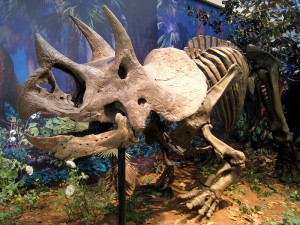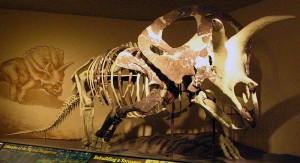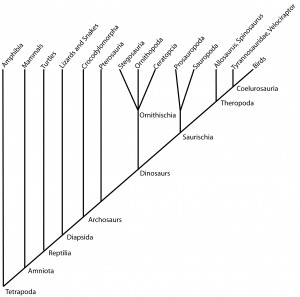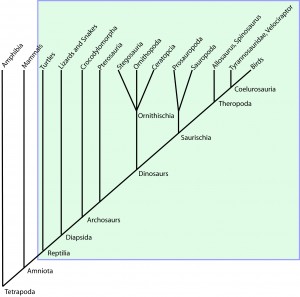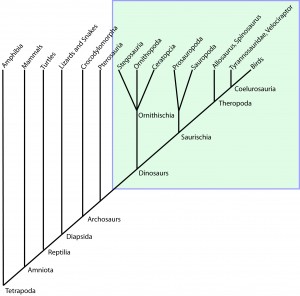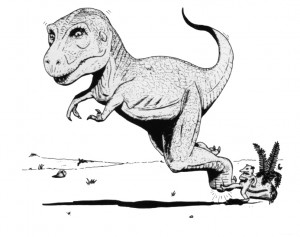I have the privilege to work as a professional paleontologist. Many people are excited by fossils and beasts from the past, and the media loves to cover new discoveries. Periodically, a friend will ask if I had heard of the latest fossil find being discussed by the media, almost always touted as the latest, the greatest, the biggest, or the best example of whatever. With genuine enthusiasm my friend will ask how thrilled I am about it. While I really appreciate their eagerness for me and my profession, when the fossils were collected by someone hoping to sell them I have to say, no, I am not really excited about the find.
My friend will usually blink a few times, trying to understand how I could feel that way. How can I help them understand why academic paleontologists are not excited by such specimens? Why if I have dedicated my career to learning about life of the past would I not even be interested in seeing such fossils? Wouldn’t all scientists be falling over themselves with glee to see these treasures? No.
The latest example is the so-called Dueling Dinosaurs from Montana, and much has been written about them, a meat-eating and a plant-eating dinosaur found together, promoted as having died in mortal combat. But these fossils are simply the latest example in the long-standing conflict between science and the commercialization of fossils. The key to easily understanding this conflict is to understand the two very different ways of appraising the value of a fossil: commercial and scientific.
We are immersed in the commercial value of things. Everything has a price. All around us in everyday life we see prices placed on goods and services. We are so comfortable making judgments about the monetary value of items we even have game shows like the Price is Right where we compete with each other to do so.
Additionally, we are familiar with collectors of all types. Art collectors, people who collect baseball cards, or old bottles. We occasionally hear of a rare collectable item selling for high prices, and fossils seem like they could be in that same category of potentially valuable collectable items.
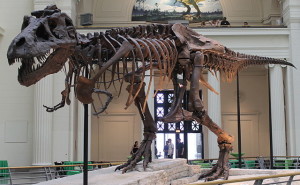
“Sues skeleton” by Connie Ma from Chicago, United States of America – Sue, the world’s largest and most complete dinosaur skeleton.Uploaded by FunkMonk. Licensed under CC BY-SA 2.0 via Wikimedia Commons
High-profile fossils have occasionally been valued at very high market values. The Tyrannosaurus “Sue” sold at auction for over 8 million dollars. Recently another similar dinosaur was to be sold for over a million. The sellers of the Dueling Dinosaurs are reported to want 7 to 9 million. And the implication is clear—you can get rich on dinosaurs.
In our market-based society it is easy for non-scientists to think that market value must be the same as scientific value. High-dollar fossils must be worth more to science, right? This equivocation, however, is false.
To appraise the market value of a fossil you have to know what a willing buyer will pay a willing seller under current market conditions.
The scientific value of a fossil is very simply its ability to add to existing knowledge. To appraise the scientific value one needs to know about all the research that has taken place to date, all the specimens currently known to science, and an individual fossil’s potential to tell us something we didn’t already know.
The issue hinges on the fact that for a fossil to have high scientific value we must be extremely confident in the reliability of the information that accompanies it. The commercial collection of fossils is usually driven by other pressures, and unfortunately there are far too many examples where the information valued by scientists is not collected. Or worse, where the information is unreliable or even falsified. Too frequently people looking to sell fossils for large monetary gain collected the fossils illegally, or dishonestly, and then seek to hide those facts from buyers. The temptation of large payoffs is often too great.
From a scientific stand point the value of a fossil is significantly reduced if we do not know, or cannot rely on, certain basic information. Where did the fossil come from? Who collected it? Can we be sure it is one fossil or is it a composite of two or more fossils? Could it be a forgery? Do we have records of the fossil’s context with the surrounding rocks? What did the rocks tell us about the environment in which it was buried? What other fossils were found with it that would give clues to the environment in which it lived? What clues were with the fossil that may have gotten removed during the preparation of the fossil?
The primary “currency” of academic paleontologists is integrity—if our colleagues lose trust in our work and our word we have nothing. So, there is little incentive to deceive or falsify our data or claims, and in fact there is a great potential for career-ending consequences if one is caught being dishonest.
Unfortunately that is not the case for commercial collectors. In a climate where you can sell a fossil for millions of dollars you just need to do that once to be set for life. The integrity and motivations of commercial collectors is then suspect; there are just too many examples of theft, lies, and deceit.
I am not implying anything about the people involved in the Dueling Dinosaurs. Rather, I am saying that the general lack of academic enthusiasm for their fossils is because of past experience. The prices demanded are out of reach of museums and the risk of obtaining false data is just too great. When the next biggest, best, and rarest fossil comes around we must watch their sale with detached sadness, and hope for the best.
Perhaps the Dueling Dinosaurs will end up at a museum, and maybe any questions about the integrity of those fossils can be satisfactorily addressed. Perhaps those fossils will become a conversation piece in someone’s trophy room, and if so they will likely be lost forever to science and by extension to all of us.
Fortunately, the public lands of the United States are available to researchers, where the ownership of fossils is clearly established to be the public, and commercial value plays no role. There, and on private land generously made available by land owners, scientists and genuine amateur enthusiasts can collect, study, and learn about the past with fossils that can advance our knowledge.
For the landowners, field collectors, and the people involved in buying and selling fossils I guess I have to say I don’t blame you for your interest. Fossils are cool. And if you make a million dollars, I guess good for you. However, understand that the commercial collection and sale of fossils has virtually nothing to do with the science of paleontology. The only commonality between the two is the fossils, and whereas commercial fossils may have a high market value, their scientific value is severely compromised.
